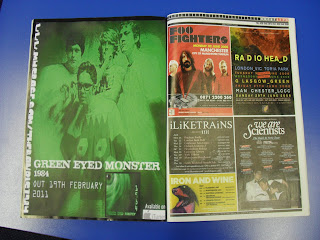
Friday, 11 March 2011
The End . . . .

Thursday, 10 March 2011
So . . . What Now?
Friday, 4 March 2011
Evaluation: Question 4
The presentation above tells you what new media technologies we used this year, these are different from the technologies we used last year. Last year we used:
- Blogger
- IMovie
- DVD Camera
Its good that we got to use new technologies this year as it gives us experience using different media interfaces and gives us a chance to develop different media techniques. This year's technology was more advanced however, for example we upgraded to an HD Camera which gave our videos better clarity of picture.
In the presentation, i forgot to mention a resource that was quite valuable to our research stage, 'Channel 4'. Early in 2010 Channel 4 made a program called "Top 50 Music Videos" and we referred to this in the blog and some video ideas have reflected in our own video. This was the first time we had come across videos such s 'Sabotage' by 'Beastie Boys' and this helped give us an insight into the history of the music video.

Thursday, 3 March 2011
Evaluation: Question 3 Wordle

Evaluation: Question 3














Tuesday, 1 March 2011
Evaluation: Question 2
Monday, 28 February 2011
Evaluation Question 1
Saturday, 26 February 2011
Green Eyed Monster Montage: OneTrueMedia
Friday, 25 February 2011
Postmodernism and Our Music Video
- No meta-narratives
- Non-linear storylines
- Borrows from past texts
- Blends genres
- Lack of morality
- Nothing is new




Tuesday, 22 February 2011
Representation in Our Music Video





Monday, 21 February 2011
Suture
Friday, 18 February 2011
Reception Theory and Our Music Video


Reception Theory
- Dominant or Preferred
- Negotiated
- Oppositional
Tuesday, 15 February 2011
The Uses and Gratifications Model and Our Music Video
The Uses and Gratifications Model
- Diversion
- Escapism
- Information
- Pleasure
- Comparing Relationships and Lifestyles with one's own
- Sexual Stimulation
- Learning
- Emotional Satisfaction
- Relaxation
- Help with Issues of Personal Identity
- Help with Issues of Social Identity
- Help with Issues of aggression and violence
Sunday, 13 February 2011
The Effects Model or Hypodermic Model and Our Music Video

The Effects Model or The Hypodermic Model
- children watched a video where an adult violently attacked a clown toy a Bobo Doll
- The children were then taken to a room with attractive toys that they were not permitted to touch.
- The children were then led to another room with Bobo Dolls.
- 88% of the children imitated the violent behaviour that they had earlier viewed. 8 months later 40% of the children reproduced the same violent behaviour.
Saturday, 12 February 2011
Audience Theories
- The Effects Model or The Hypodermic Model
- The Uses and Gratifications Model
- Reception Theory
Tuesday, 8 February 2011
Critical Theory: Levi-Strauss - Narrative

Monday, 7 February 2011
Critical Theory: Tzvetan Todorov - Narrative

Sunday, 6 February 2011
Critical Theory: Vladimir Propp - Narrative

Saturday, 5 February 2011
Critical Theory: Laura Mulvey - Feminism

Laura Mulvey argues with feminist views, which means that the production somehow detracts from being a woman. She argues in her theory that the camera is that of the "Male Gaze", which is active. The narrative is male directed in which they gaze towards female characters. So in many cases, females are simply used as a love interest or sexual desire for either those on screen or those in the audience. She believes that the narrative or plot/storyline of a production follows males, are influenced by males and flows mainly because of male participation.
This can be applied to our music video both positively and negatively.
Our video partially agrees with mulvey’s feminist theory as all of the cast are male and there is only one ‘woman’ in the whole video, but this is played by a male, and ‘she’ is very stereotypically shown in a red provocative dress. The woman figure is used for pure humour sense, so it could be said that we simply used a female to poke humour at. This is largely true but is also true for all of the characters in the video, most of whom are men. Either way, the view of women in our video is quite derogatory as for a few seconds she is supposed to be seen a sexually desirable, and is then poked fun at.
Thursday, 3 February 2011
Audience Feedback: Survey Monkey








Tuesday, 1 February 2011
Magazine Advert Finished


Friday, 28 January 2011
Information for magazine Advert
information to be included on the advert includes;
- Artist name
- Song name
- Release Date
- Website
- Digipak Picture
Tuesday, 25 January 2011
Digipak Finished Project






